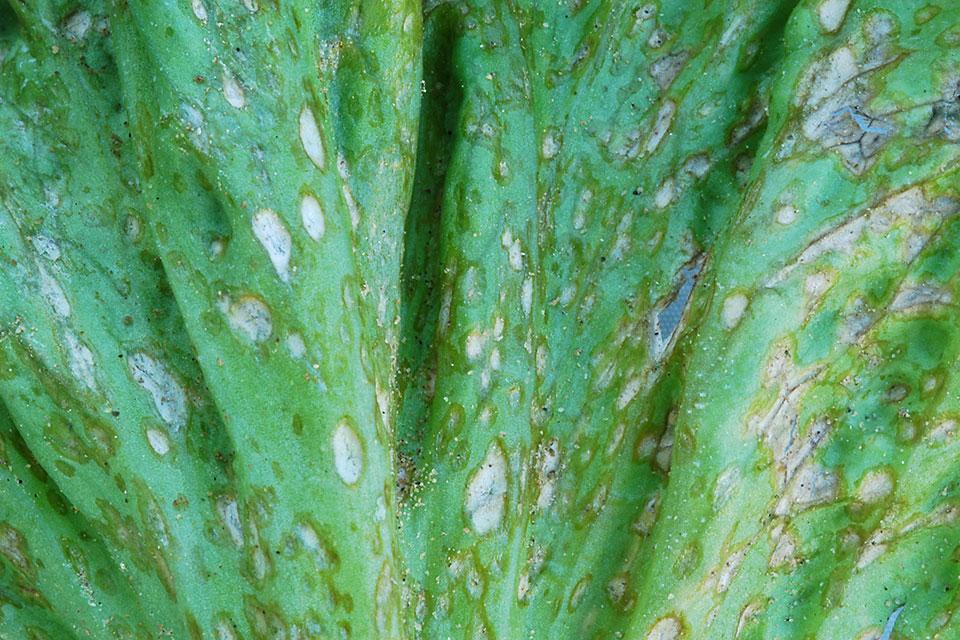Effective Vegetable Disease Control Depends on Record Keeping

Recording plant disease distribution on a map can inform a grower of problematic regions of the block.
Photo by Steven T. Koike
Success in agriculture depends on collecting and recording key information. It demands accurate data on all inputs, such as the fertilizers used and their costs, cultivar of the seed planted, tractor hours and fuel used to work the ground, water costs, pest control costs, and employee hours for all steps from planting to harvesting.
Recorded output data are equally essential and include quality and quantity of the final harvest and, of course, the harvested commodity’s per-unit market price. Success in managing crop disease is also dependent on collecting and recording important data.
Field Disease History
It is essential to maintain records of plant diseases that occur in every planted block. Which diseases did you find on each crop planted at that location? Did a diagnostic lab confirm the pathogen? Were there multiple diseases happening concurrently — and did diagnostic
efforts differentiate these?
Botrytis and Sclerotinia on lettuce look very similar; tomato spotted wilt virus on pepper can cause leaf spots that look bacterial. If appropriate, was the lab able to provide information on the strain or race of the pathogen? Knowing which race of Fusarium was found in collapsing celery is a key detail.
These data on field disease histories are important to collect for both soilborne and aerial/foliar problems. Collected season by season, such information allows you to see trends of developing problems, to detect evidence of spread between fields, and to justify production decisions such as changing plant varieties and altering crop rotation plans.

The lettuce anthracnose pathogen is soilborne and only infects during rains. Remembering which fields have the problem will help growers plan for the next rainy season.
Photo by Steven T. Koike
Mapping Plant Disease Distribution
For larger acreage parcels, monitoring disease distribution by mapping the field can be insightful for soilborne challenges. Disease incidence maps help us visualize the problematic sections of the field and can provide clarity to the field situation.
For example, plant decline may be associated with low spots in the field, areas with heavier or poorly draining soil, or head- or tail-end parts of the field where irrigation water is deficient or excessive, respectively.
Management decisions can be partially based on maps. A grower may be able to plant a tolerant or resistant cultivar in the problematic half of a field while planting a preferred, better-yielding variety in the clean part of the field.
Interactions and Associations
Preserving crop disease information for specific blocks, and over multiple seasons, allows farmers and other field professionals to understand some of the factors accounting for problems.
1. Crop rotations: Some plant pathogens can infect several crops. Noting the crop rotations used on ranches can explain why certain pathogens might be increasing. The Verticillium wilt pathogen can infect lettuce, artichoke, strawberry, and other crops. Crop rotation records that show the planting of multiple Verticillium hosts provide evidence for why the pathogen may be increasing in severity.
2. Time of year: Records may show that some problems are more severe at certain times of the season. Some soilborne pathogenic fungi and some vector-spread viruses are more damaging in late summer and fall in comparison with spring. Multi-year records documenting when problems show up can give growers advanced warning about when disease pressure can be expected to build up.
3. Cultivars: You will find it helpful to record which cultivars perform well in the field and which others readily succumb to disease. Recorded data on cultivar performance can guide you in variety selection on a per-field basis.
For instance, you will clearly see which spinach varieties are resistant or susceptible to the downy mildew races in your region based on whether your plantings develop the tell-tale yellow leaf lesions. You can select future spinach cultivars based on these records.
4. Environment: Weather, of course, is a driving factor in plant disease development. Ranch notes should record disease development in relation to weather data. During California’s multiple-year drought, the soilborne anthracnose pathogen of lettuce was never seen because the organism is highly dependent on splashing rain. However, the extensive rains of spring 2023 allowed anthracnose to significantly damage fields.
You should record which blocks had anthracnose in 2023. If rainfall happens in a subsequent year, you can either avoid these known infested blocks or be ready to deploy protectant fungicides on the young lettuce.
More Is Better
In general, the more thorough and complete the collection and preservation of field disease data, the better. Such data are the basis for formulating a more effective disease management strategy. Incomplete and sketchy data threatens to leave the farmer in the plant pathology dark. With less information to go on, you are subject to increased losses from crop diseases. Given the high costs of farming, such losses are too costly to risk.










